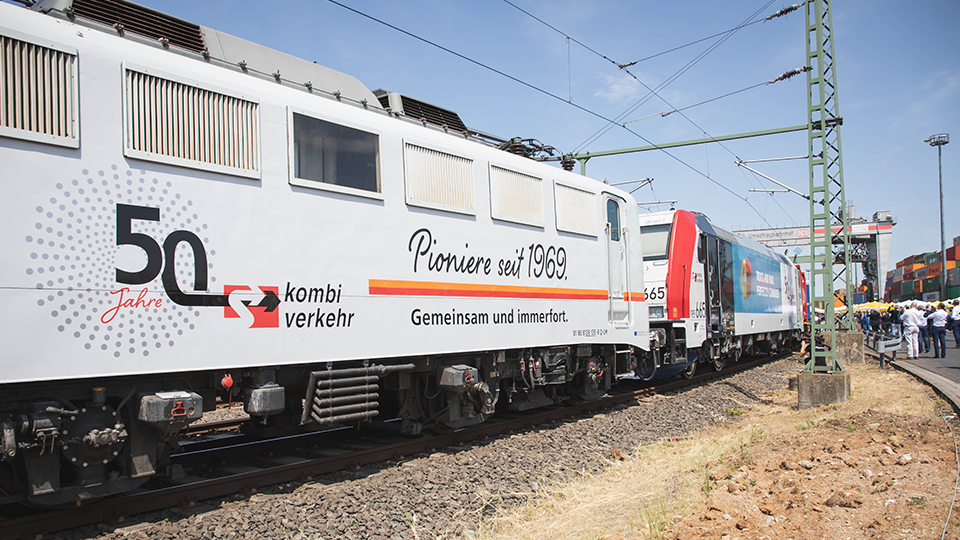
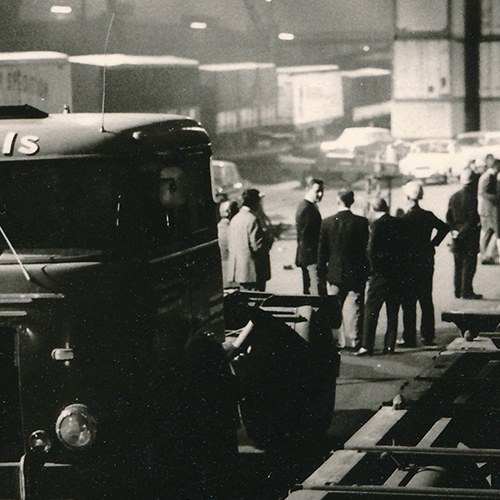
Five decades of intermodal transport - an impressive history. Time and again, we have set new standards and made intermodal transport successful in Germany and Europe. See for yourself.
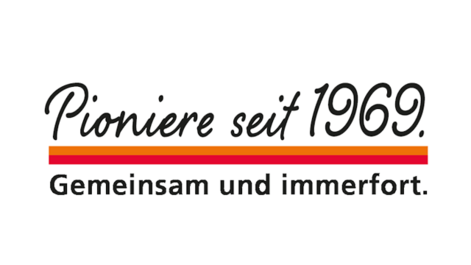
While Transport Minister Leber was working on his programme for the recovery of the German transport system, the so-called "Piggyback Transport Working Group" had already been in existence within the Federal Association of German Long-Distance Freight Transport (BDF) since 1964 and had been primarily concerned with the loading of semi-trailers onto the railways since the mid-1960s. In addition to discussing Leber's ideas in political working groups, this working group was also consulted from 1967 onwards in order to prepare the foundation of a company to promote combined road-rail transport. Over the course of several meetings, the members worked on an initial outline of ideas to bring the new company to life. Among other things, the first draft of the articles of association for the Kombiverkehr Kommanditgesellschaft, which is to be founded at a later date, was drawn up. They also discussed possible new connections for combined transport and their timetables.
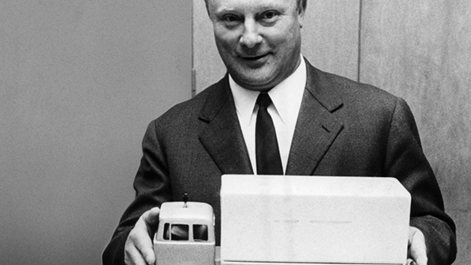
The "Leber Plan" is the colloquial name given to a basic transport policy programme for the Federal Republic of Germany presented on 22 September 1967 by the then Federal Transport Minister Georg Leber (SPD), which is also known today as the "Programme for the Recovery of the German Transport System 1968 to 1972".
In view of the steadily increasing strain on the German road network (the number of passenger cars on the roads rose from 4 million in 1960 to 10.3 million at the end of 1966) and the simultaneous decline in rail traffic on the Bundesbahn, Leber pursued a plan to curb the growth in road traffic and at the same time utilise underutilised railway capacity. In the nine months between his taking office and the publication of the policy programme, Leber first investigated the situation of the German transport system, then developed possible solutions and discussed them in depth in working groups, with the aim of achieving a division of tasks within five years in free competition between the modes of transport that would take account of the natural conditions and performance capabilities of the individual modes of transport.
The interaction of the individual modes of transport in combined transport was to be ensured. Part of this policy was also a heavy taxation of lorry traffic for road transport with the so-called "Leber-Pfennig" of 1 Pfennig per tonne-kilometre, targeted subsidies for rail and also for combined transport, in particular the construction of 50 transhipment facilities. 250 million German marks were made available each year during this period to promote rail transport.
The programme was made public in October 1967 and a new company was to be set up to organise the interaction between road and rail. Leber commissioned the Bundesverband des Deutschen Güterfernverkehrs, the Bundesverband Spedition und Lagerei, the Deutsche Bundesbahn and employees of his ministry to implement the programme, and the "Leber Plan" was thus the main reason for the foundation of Kombiverkehr.
"A child of '68" - The founding of Kombiverkehr GmbH
Kombiverkehr GmbH is founded in Frankfurt am Main on 24 September 1968. The main sponsors are the two associations Bundesverband des Deutschen Güterfernverkehrs (BDF), based in Frankfurt am Main, and Bundesverband Spedition und Lagerei, based in Bonn.
The managing directors of the GmbH appointed by the association presidents are lawyer Hans Wenger and business graduate Günter Malkowsky. The company was co-founded by Deutsche Bundesbahn, Bundes-Zentralgenossenschaft Strassenverkehr, Arbeitsgemeinschaft Möbeltransport and Güterkraftverkehrsunternehmer der Bundesbahn.
The share capital of the GmbH amounts to one hundred thousand German marks, but the presidents of the associations do not see the foundation of such a company as a real success at this time. In order to win over the railways and the forwarding and transport industry for combined transport, to promote their sustained interest in the successful implementation of Leber's modal shift idea and to bind both to Kombiverkehr in the long term, a limited partnership is to be founded alongside the GmbH.
The aim is to have shareholders, particularly in the initial phase, who have the technical expertise on the rail side on the one hand and on the road side on the other and can contribute this to the activities of the still young company.
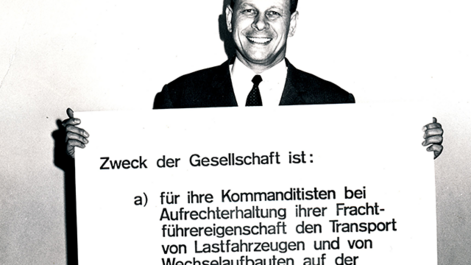
Big crowd at the Haus des Straßenverkehrs - the limited partnership is founded
On 11 February 1969, the associations for long-distance freight transport, freight forwarding and furniture transport, with the participation of Deutsche Bundesbahn and 56 road hauliers and trucking companies, founded Kombiverkehr Kommanditgesellschaft in the large conference room of the Haus des Straßenverkehrs in Frankfurt am Main. The founding managing directors are Hans Wenger from the Federal Association for Freight Transport and Günter Malkowsky from the Federal Association for Forwarding and Logistics. The purpose of the company is to organise and carry out the transport of trucks and swap bodies by rail for its limited partners while maintaining its status as a freight carrier. With their signatures, the companies present seal their entry into the limited partnership, together with the payment of their limited partner's contribution of 5,000 German marks.
Excerpt from the Deutsche Verkehrszeitung of 13 February 1969:
"... The interest was greater than expected. The future commanding officers and accompanying personnel crowded together, seats were rare, the mood and atmosphere were hopefully optimistic, sometimes even downright harmonious. The observer must have enjoyed the picture that presented itself: Transport companies and lorry hauliers of all sizes were literally jostling for position. They wanted to get rid of their money as quickly as possible, usually symbolically by signing. The very eager, however, had brought the completed cheque with them ... "
The complete historical press article on the founding: DVZ
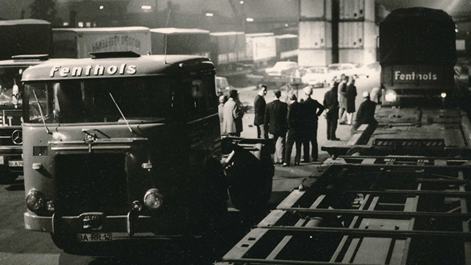
Champagne christening for the first train from Frankfurt am Main East
Kombiverkehr KG begins operations on the evening of 1 July 1969. At the Frankfurt am Main (East) loading station, nine semi-trailers are loaded onto low-floor wagons by dedicated transport companies in the presence of the management and representatives of Deutsche Bundesbahn. The semi-trailers, which are driven onto the wagon with the help of the tractor unit and locked in place by manually positioning the support frame, are destined for the Hamburg region. The Frankfurt - Hamburg v.v. connection is part of Line 2, which connects Mannheim and Frankfurt in the centre of Germany with Hanover, Bremen and Hamburg in the north. At this point in time, Line 1 already exists with several dispatch and receiving stations between Düsseldorf and Munich. Lines 3 and 4 are already being planned for realisation before the end of 1969. All combined transport lines run overnight - loaded in the evening, at the destination in the morning.
Press articles on the foundation at the time:
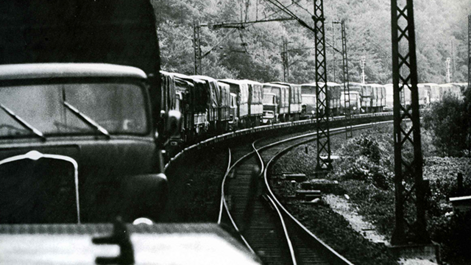
Starting gun fired for the first Rolling Road of Kombiverkehr KG
Following the commencement of transport operations with swap bodies and semitrailers in Frankfurt am Main on 1 July 1969, the starting gun for the first Rolling Road is fired in autumn of the same year. After a successful trial in mid-September, complete load trains are transported in piggyback fashion on the rail line between Köln-Eifeltor and Ludwigsburg, near Stuttgart, from 1 October. This is made possible by the use of 24 special low-floor wagons of type Simmering-Graz-Pauker that the Bundesbahn has purchased. Two load trains, consisting of truck and trailer, are carried on every three wagons. A total of 16 trucks are transportied, departing Cologne at 19.58 that evening and reaching Ludwigsburg at 01.40 the next morning. The drivers sleep in the couchette. The forwarder pays 355 marks for the one-way journey. Trains are scheduled to depart daily.
Three become one – Licences in Combined Transport
The history of long-distance road haulage shows that commercial freight transport has been strictly regulated in Germany since the emergency decree on overland transport of 6 October 1931. The aim was to regulate competition between road and rail transport by introducing a licence requirement, a quota system and price rules under the German Reich road traffic tariff (Reichskraftwagentarif - RKT). A distinction was made between works traffic and commercial freight traffic, and a local transport zone of 50 kilometres was established.
Long-distance freight forwarding permits must be deposited with Deutsche Bundesbahn in order to take part in Combined Transport. International transport is exempt from this requirement.
By depositing only one licence on a daily basis, the forwarder can arrange two or three rail journeys, depending on the transport distance. In 1972 it is possible to transport 70 piggyback consignments on any day of the month with a one-month licence, with this figure rising to 90 from 1987. An important reason for forwarders to use Combined Transport on a sustained basis.
The tariff requirement in the road haulage sector is abolished at the turn of 1992/1993, making it possible to enter the market with a collective licence. The national licences no longer apply.
Crossing the border for the first time – Unaccompanied transport to and from Paris
October 1970 sees the first foreign route offered by Kombiverkehr KG in unaccompanied transport: Frankfurt/Ludwigsburg – Paris. As expected, it develops slowly. This is because the price and journey time do not yet make the Combined Transport service sufficiently attractive for operators. Another reason is the lack of approved swap bodies that would allow better use to be made of the corner height of just 3.20 metres allowed in France. This is exacerbated by the difficulty that it is not always easy to obtain approval for collecting French trailers using German tractors and vice versa from the stations, impairing collaboration between the French and German transport operators.

To West Berlin as early as 1972
Kombiverkehr starts moving goods to West Berlin in response to the transit agreement between the FRG and the GDR on 17 December 1971. There is an end-to-end Combined Transport service by rail from Bochum, Bremen and Hanover to West Berlin from 1972. The trains run several times a day, carrying food – and coffee in particular – from Bremen for the citizens of West Berlin. The transport units are mostly empty on the return journey, which is not really much of a problem for the forwarders due to the existing empty load price of Deutsche Bundesbahn.
Kombiverkehr arranges transport services as far as the Helmstedt border crossing in conjunction with Deutsche Bundesbahn. Over in the east there is a contractual relationship with Deutsche Reichsbahn, which pulls the trains as far as the "Hamburger- und Lehrter Güterbahnhof (HuL)" terminal in Berlin and is in charge of crane operations to load and unload the transport containers.
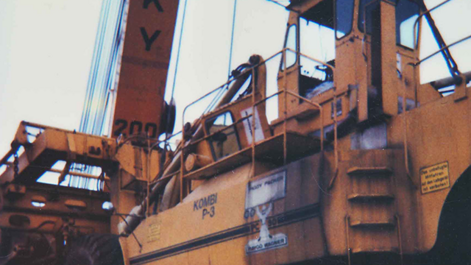
In 1972 Kombiverkehr imports the first mobile, rubber-tyred and non-rail-dependent cargo handling vehicles, going by the name “Piggy Packer”, from overseas into Germany. Since there are no mobile straddle carriers for loading transport units in Europe at the time, Kombiverkehr buys the necessary equipment in from the USA.
The first Piggy Packer is installed in Neuss, where it facilitates the loading and unloading of trucks in the new terminal from January 1973. In 1974 a second such carrier is installed in the Köln-Eifeltor terminal. Including transport and customs duties, a Piggy Packer costs DM 650,000.00.
These innovative cargo handling vehicles allow truck swap bodies and semitrailers to be lifted, moved and set down with grapplers. The swivel pins of the spreader grip the upper corner fittings of the containers. Each Piggy Packer has a lifting capacity of 40 metric tons, a maximum total weight of 100 tons and a handling interval of about three minutes.
This acquisition demonstrates how Kombiverkehr was even then able to optimise its core business with new and expanded business fields thanks to pioneering technology projects.
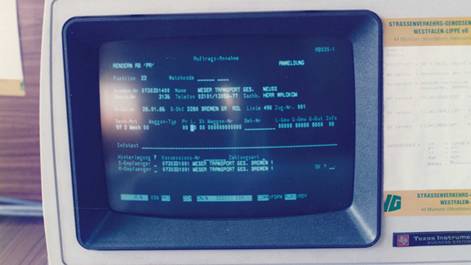
Eigens IT-Fachpersonal für eigene IT-Programme
In-house IT experts for in-house IT programs
In the mid-1980s Kombiverkehr begins to program IT applications itself, recruiting specialists just for that purpose. The company introduces the first programs in 1986. These are designed, developed and programmed in-house from then on. The very first program is called “KIS” and is a customer information system, followed by “ABS” for order processing.
In 1992 ABS is replaced by the successor system, Alibaba. KIS is used by the staff until 1999 and then superseded by the new KOBRA system for the commercial processing of invoices and orders. Initially it is still referred to as “the new KIS”. KOBRA is mainly introduced because the manufacturer of KIS discontinued maintenance support for the program. Kombiverkehr also needs a new system in order to handle the commercial processing of the block trains that it now offers, as the previous KIS was unable to provide this option.
Even today, Kombiverkehr still programs the majority of its essential IT systems itself. This is the only solution if all the requirements and specifications that the company places on the systems are to be met efficiently, promptly and economically. Some assistance is obtained by awarding contracts to IT service providers and web agencies.
Block trains – The new standard for the future
Kombiverkehr buys block trains with fixed rolling stock for the first time, deploying them between Cologne and Verona from 29 May 1989.
Piggyback transport from Germany to Italy via the Brenner Pass is part of what is known as the Brenner strategy for relieving the Brenner route. The switch to block trains must be seen as complementing the expansion of the product range in unaccompanied transport, helping to improve its attractiveness by enhancing quality. The new block trains can for the first time run from Cologne to Verona without the need for shunting. This allows shorter journey times from day C to day B as well as higher punctuality rates to be achieved.
The switch to block train prices in freight invoicing with the railways also gives the companies involved in Combined Transport greater flexibility when it comes to pricing, which is adjusted with the change in rate systems in 1992.
Today Kombiverkehr buys in all national and international routes as block trains from the railways and markets them to the forwarders.
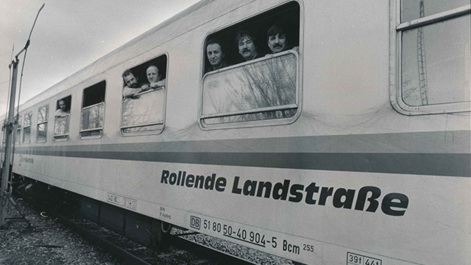
Transalpine transit with truck and couchette – Ingolstadt-Brennersee v.v. launched
Following the introduction of the first Rolling Road between Cologne and Ludwigsburg in 1969, the
first international RoRo service from Cologne to Verona in 1972 and further routes such as Munich – Ala or Mainz – Gustavsburg, the end of the eighties sees the advent of one of probably the two best known and most legendary Rolling Roads offered by Kombiverkehr.
Launched on 1 December 1989, the new Ingolstadt – Brennersee v.v. route offers five train pairs a day. The new product is intended to help relieve road transit traffic through the Alps. Right from the start capacity utilisation in the north-south direction reaches 60 to 70 per cent, rising to more than 80 per cent in the first few months of 1990. Several of the five daily departures are regularly booked out during this period, so that a tangible increase in volumes carried on this route can only be realised with additional trains and improved timetabling.
Due to traffic jams in Ingolstadt city centre, in May 1994 the Rolling Road is relocated from Ingolstadt’s main railway station to Manching. The Manching – Brennersee RoRo reaches its heyday in 2003 with 15 train pairs a day, before utilisation drops sharply following the abolition of the ecopoint system in Austria. The service is terminated in December 2004.
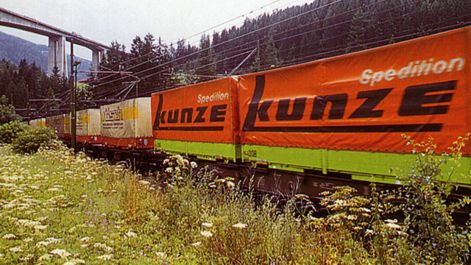
New trains from West Germany to the GDR
The fall of the Berlin Wall in November 1989 and the subsequent reunification of Germany opens up further territory for Kombiverkehr within Germany. Together with the Bundesbahn and the Deutsche Reichsbahn, East Germany's equivalent, new piggyback routes are added with the aim of opening up key locations in the east of Germany to forwarders and transport companies committed to Combined Transport. Having already offered services to and from West Berlin in 1972, Kombiverkehr launches the first combined trains after the fall of the Wall from West Germany to Dresden, Leipzig and Zwickau in the GDR in September 1990. The trains depart Bochum and Frankfurt am Main and travel overnight. A direct train also serves Berlin from Nuremberg at this time.
Further routes are introduced in 1991, including trains from Dresden and Zwickau to Nuremberg and Munich with onward connections to and from Italy as well as trains from Berlin, Leipzig and Zwickau to Stuttgart. Here you find the brochure "Unbegleiteter Huckepackverkehr".
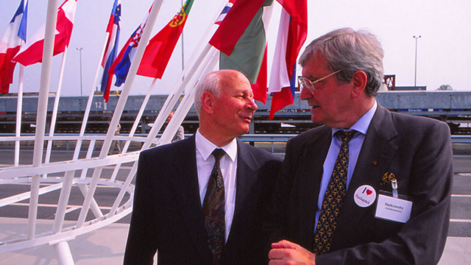
Kombiverkehr celebrates 25th birthday
On 29 June 1994 Kombiverkehr celebrates its 25th birthday at the Hamburg-Billwerder terminal in the presence of the then federal transport minister, Matthias Wissmann, and some 300 guests. With a wide range of supporting events, an address by the minister and further speeches by key personalities in Combined Transport, this hot summer’s day will go down in the annals of the company.
The words “Hooray, we’re still alive!” of current Administrative Board chair Gudrun Winner-Athens during her speech on the “Wishes and hopes of a user of Combined Transport” will never be forgotten. Alluding to the 50th anniversary of Kombiverkehr KG in 2019, she calls on transport politicians to look at future collaboration from the perspective of the railway. Gudrun Winner-Athens is joined as speaker by the then president of the Federation of German Long-Distance Freight Transport, Dr. Eberhard Sinneker (of Deutsche Bahn Beteiligungsgesellschaft), Werner Külper (chairman of the Administrative Board of Kombiverkehr KG), Dr. Werner Maywald (on behalf of the management of Kombiverkehr KG), Eugen Wagner (Hamburg senator) and Bernhardt Bünck (president of the Federation for Forwarding and Warehousing).
Here the complete DVZ press article including a caricature concerning the jubilee
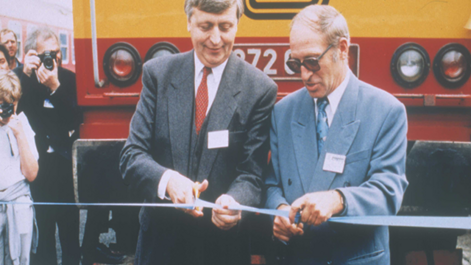
On the Rolling Road through the Erzgebirge mountains
Kombiverkehr organises a rather special kind of Rolling Road on behalf of the Saxony Ministry of Economics and Labour in 1994. A service between Dresden and Lovosice in the Czech Republic is launched in ultra-quick time as an emergency measure to relieve pressure on the roads and at the border crossings through the Erzgebirge mountains. Thanks to smooth and efficient cooperation between the participating rail operators, local authorities and Czech partner company Bohemiakombi, large portions of the heavy goods traffic start to roll over the 100 kilometre-long train track through the Elbe valley on 25 September. That means more than 17,000 truck drivers in almost the first four months alone are spared the slow journeys along narrow roads through villages in the mountains and waiting times of up to 36 hours at the border.
Saxony's government spends just under ten million euros on the pilot project by the end of 1995. The attractiveness of the product declines as the subsidies are later withdrawn. The 750,000th truck is carried on 11 June 2003. Up to twelve train pairs a day, each with a capacity of 23 spaces, are offered in 2003.
Following the accession of the Czech Republic into the EU and the resulting abolition of the need for a permit, capacity utilisation falls to less than ten per cent. On 18 May 2004 the decision is taken to discontinue the product. The last Kombiverkehr RoRo train rolls through the Erzgebirge mountains in June 2004.
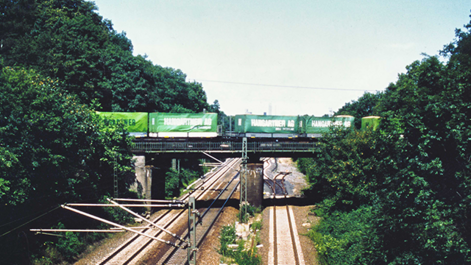
A novelty in the intermodal industry: Kombiverkehr schedules the first company train
14 January 1996 marks the first trip of a company train of Kombiverkehr KG, beginning a whole new chapter in the history of the company to date. Whereas national and international trains in accompanied and unaccompanied transport have until now been the “mainstay” of Kombiverkehr, the start of this service offered by the company that day opens up another important sales avenue. That's because company trains now make it possible for major forwarders to tailor individual train products entirely to their own requirements on frequency and timetabling and commission such a service.
Here too, Kombiverkehr KG is really blazing the trail. Kombiverkehr is the first operator in Europe to introduce company trains as a new product in partnership with a major customer. What in the midnineties is initially regarded with extreme suspicion by many other operators will eventually go on to be copied many times. The unique ability to book fixed capacities will increasingly be transferred to open trains within Kombiverkehr’s product range over the following years. Even today, forwarders can book “fixed” part capacities on trains.
The first company train is ordered by the then Hangartner AG. Kombiverkehr runs it as an international service on the Rostock – Verona v.v. route on behalf of the customer. From Rostock the train has onward connections to and from Trelleborg via the Baltic Sea ports. The combination of ferry and truck is used mainly for transporting goods and articles of a large Swedish furniture chain.
Complementing the open train products available to any forwarder, this particular business field becomes an important pillar of Kombiverkehr from 1996 to today. A large number of company-owned trains now use the Kombiverkehr network.
From a co-operative to a commercial enterprise
To strengthen Kombiverkehr’s profile as a forward-looking commercial enterprise, the partners agree to a far-reaching change to the articles of association on 27 June 1996. The existing partners of the company – the road freight transport associations and Deutsche Bahn – sells their shares to the partnership, thereby laying the foundation for what is known as a limited partnership structure. At the same time, the associations and Deutsche Bahn join the partnership as limited partners, DB with a double contribution giving it the right to send two representatives to the administrative board of the partnership.
To enable continued access to the specialist expertise provided by the associations, an advisory board is formed. It establishes the appropriate by-laws in its constitutive meeting on 20 March 1997 and will in future be available to offer advice to the Administrative Board and the management team.
The press articles "Kombiverkehr im Umbruch" and "Kombiverkehr mit neuer Satzung" offers you more details about the change to the articles of association.
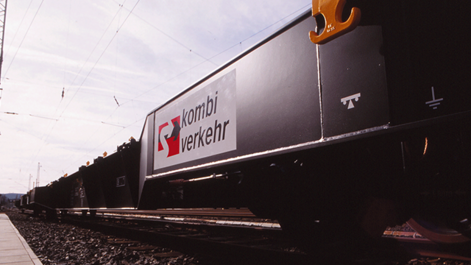
First use of proprietary wagons
In March 1997 Kombiverkehr uses the new 73-foot container carrier on the Köln-Eifeltor – Verona v.v. route. These wagons, which are nicknamed “bananas” due to their shape, allow the greatest possible number of consignments for the rolling stock used on the route. They are the very first wagons that Kombiverkehr buys and puts into operation.
Among the outstanding features of the 73’ container carriers of type Sggns are their low tare weight of just 22 metric tons, the rubber roller springs, gas hydraulic buffers, hardened buffer plate and long overhang. The 73’ container carriers are used primarily to transport up to three 7.45 m-long swap bodies and containers. This means they can carry heavy Euronorm tanks, for instance, but other container combinations can also be loaded optimally onto the carrier. The carriers are manufactured by Talbot, an Aachen company.
Kombiverkehr still has 23 of this type of carrier in use today.
Kombiverkehr is licensed as a railway undertaking
In November 1999, Kombiverkehr receives a licence as a public railway undertaking and thus the "authorisation to provide rail freight transport services". This gives Kombiverkehr the opportunity to buy routes from the respective network operators and make them available to those traction providers who are able to carry out these transport services the most efficiently and, if necessary, provide its own traction.
In its capacity as a licensed railway undertaking, Kombiverkehr provides its own traction services on the German rail network in 2007. When the quality of the seaport hinterland services ex Rotterdam were on the verge of permanent decline, there was a need for partners to act quickly, flexibly and unbureaucratically with the aim of achieving a significant improvement of quality. In agreement with DB Intermodal, Kombiverkehr makes use of its licence as an authorised railway undertaking for the first time to use its own traction on the Rotterdam – Duisburg RSC route. Kombiverkehr takes over the section of the line as far as Emmerich and RRF provides traction for the train from Emmerich.
Kombiverkehr then sets up KombiRail Europe B.V. at the end of December 2008 The holding company obtains its safety certificate in the Netherlands in mid-2009 and becomes a licensed independent railway undertaking in November 2009. KombiRail has operated end-to-end services between Port of Rotterdam and Duisburg/Dortmund by itself since the beginning of 2010. Initially covered under the Kombiverkehr flag, the service to and from Rotterdam RSC is transferred to KombiRail.
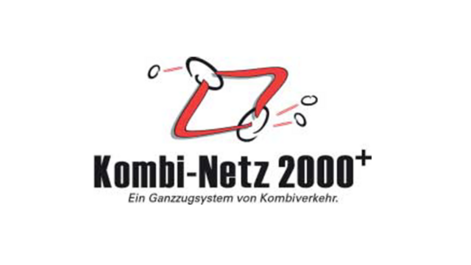
National transport reorganised: The Kombi-Netz 2000+ is launched
Kombiverkehr has to date bought the train products booked by forwarding customers from the open train system of Deutsche Bahn. The start of the new millennium sees a “revolutionary” change in Combined Transport within Germany, however. In line with its international block train network, Kombiverkehr, working in partnership with DB Cargo, switches its product range in domestic German transport to block trains alone. These connect the industrial centres in overnight shuttle services.
The 26 new trains depart their respective stations on the evening of Monday, 31 January 2000. From this day on, some 50 routes within Germany are offered in the Kombi-Netz 2000+.
The original plan is to expand the network by a further 16 trains and 30 routes in a second stage in 2001. This plan will not be realised in its entirety, but some trains will subsequently be added to the Kombi-Netz lines on selected routes where block train volumes are not yet sufficient.
The launch of the national Kombi-Netz marks a significant improvement in the Combined Transport product range:
- Fast, high-quality connections between the industrial areas
- Intensification of gateway services linking the national and international network to form a Europewide block train system
- Effective quality management together with DB Cargo and DB Netz
- Price stability until the end of 2001
- Continuous timetable improvements
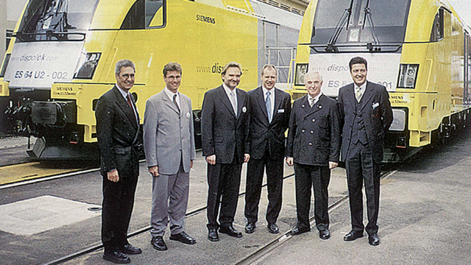
A reliable service across the Alps – Lokomotion is formed and begins operations in 2001
In January 200 Kombiverkehr KG, itself a licensed railway undertaking since 1999, helps to form Lokomotion Projektgesellschaft mbH, which in 2001 is converted from project status into Lokomotion Gesellschaft für Schienentraktion mbH.
The purpose of the newly formed Lokomotion is the operation and marketing of rail traction services. The aim of the company is to improve the quality of German-Italian rail freight transport across the Alps and draw road traffic from the Brenner motorway to the railway.
Lokomotion is the first privately-owned railway undertaking to start end-to-end traction across two national borders, which it does in collaboration with Rail Traction Company S.P.A. (RTC), Bozen, on 16 October 2001. Initially two train pairs a day run on the line from Munich to Verona and back again. Lokomotion and RTC quickly make a name for themselves as reliable providers on the Brenner axis, which is beset by huge quality issues. The trains reach an above-average punctuality rate of 85 per cent across three railway networks and two borders.
The partners of the company are now RTC, Societá Trasporti su Rotaia (STR), Bozen, DB Cargo AG, Mainz, and Kombiverkehr, Frankfurt. Lokomotion currently employs more than 200 people and together with RTC has almost 70 locomotives in the vehicle pool, 40 of which are suitable for interoperable use. It posts turnover in excess of 80 million euros.

Deutsche Bahn acquires a stake – Partnership between DB Cargo and Kombiverkehr sealed
In the 2001 financial year the limited partners of Kombiverkehr take a further decisive step towards shaping the future of the company. Cooperation is the new watchword. The trend towards professional cooperation between the two companies had already been strengthened in stages during the development of Kombi-Netz 2000+. At the same time, there are clear signs of a change in the strategic orientation of DB Cargo in favour of viewing and actively shaping Combined Transport as a market of the future. The road to a comprehensive reform of the cooperation is open. Both DB Cargo and Kombiverkehr want to continue expanding national and international transport services while simultaneously anchoring Combined Transport as a sustainable option and providing new stimulus.
Deutsche Bahn therefore joins the Kombiverkehr partnership on 1 January 2002. The aim is to improve the economic viability and attractiveness of the product range for forwarders still further by bundling the expertise of Kombiverkehr and DB Cargo, particularly in the areas of sales and production. The organisational basis for doing so is the participation of DB Cargo in Kombiverkehr in equal partnership with the forwarders. For both partners, Combined Transport is a business area with rising growth potential.
The newspaper Verkehrsrundschau reported about the change.

Fixed link complements the Scandinavian product range via the Baltic Sea ports
On 1 March 2005 the first Kombiverkehr shuttle train crosses the fixed link. Connecting Duisburg and Malmö, the train reaches its destination on an entirely rail-borne route across Jutland, the Little and the Great Belt and the Öresund Bridge – a journey time more than 24 hours shorter compared with transport by ferry. This means that a large proportion of the Swedish terminals can be reached a whole day sooner than was the case with the previous service.
For customers from the forwarding and logistics industries, the new product is a key addition to their existing routes in intermodal transport on the highly-frequented transport corridor to and from Sweden. From now on, forwarders can decide for themselves which is the most suitable route to take – by rail across the fixed link or using the train product combining with the ferry connections via the Baltic Sea ports of Kiel, Lübeck and Rostock. Alongside the geographical criteria, the price, journey time and quality of service are the critical factors distinguishing the two products from each other in the individual case.
Today the open Coevorden/Bad Bentheim – Malmö v.v. and Köln – Malmö v.v. trains as well as some company trains cross into Scandinavia over the fixed link. In 2018 Kombiverkehr shipped some 45,000 consignments over the rail-borne land route between Germany and Sweden.
Details for further information: The flyer Duisburg - Malmö

New standard for trailer transport by rail
Kombiverkehr taps into the market for large-volume transport units in 2006 with an investment in 30 newly developed pocket wagons for the transport of megatrailers by rail. The company played a key role in the development of the T3000 pocket wagon, so named because of the typical inner megatrailer height of three metres. In addition to the semitrailer coupling, which can be adjusted to three different heights, a key feature of the new T3000 pocket wagon design is the geometry of the cargo space, which is tailored to the low-lying parts of the megatrailer. That makes the cargo space suitable for 13.60 m-long megatrailers with side safety devices and fixed underride guard. The modified pocket also offers more space for the wide tyres common with megatrailers.
Following approval, the wagons are delivered to Kombiverkehr in the months of April to July 2006. The first mega pocket wagons are used on the Kornwestheim – Hamburg – Rostock block train service. Further routes in the national Kombi-Netz 2000+ and in international transport are added as the number of such wagons rises.
In September 2006 Kombiverkehr takes advantage of an opportunity to buy another 50 wagons of the same time at short notice from a current production series. Following the largest investment by the company, a further 100 wagons of this unique design are delivered at the start of 2013. That increases the number of wagons owned by Kombiverkehr to 262. They can still be found in
Kombiverkehr's inventory today.
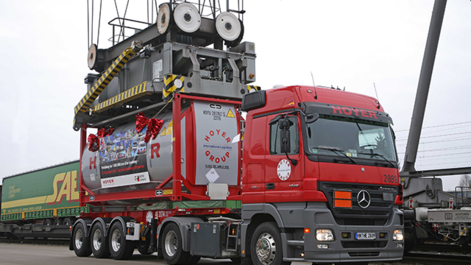
Kombiverkehr celebrates the millionth truck consignment
On 27 December 2007 Kombiverkehr achieves something unprecedented in the industry when forwarding company HOYER delivers the one millionth truck consignment for a Kombiverkehr train – a 20-foot tank container – to the Hamburg-Billwerder terminal. That makes Kombiverkehr the first operator in Europe to shift over one million truck consignments to the climate-friendly railway within a financial year.
What the DVZ wrote about the celebration: Article of 12 January 2008
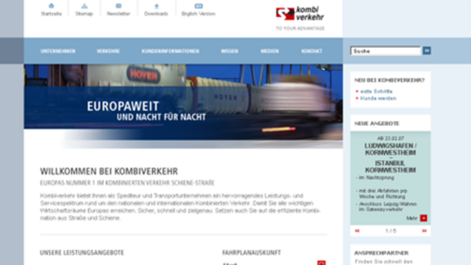
Kombiverkehr introduces online timetable information
On 5 June 2007 Kombiverkehr presents its new interactive, database-assisted timetable tool on www.kombiverkehr.de. Thanks to the new timetable information system, transport companies and forwarders can now find out online at any time the latest information about transporting a container, semitrailer or swap body on their required route by rail throughout Europe. Developed as part of the EU’s BRAVO project, the extensive database application is one of the high points of the new web presence that Kombiverkehr unveils in 2007. The final implementation of the new tool is the most important prerequisite for the new company website in its then form.
The new timetable information tool is delivered with the help of HaCon, a service provider specialising in software for planning, scheduling and information systems that is still used by Kombiverkehr today. Following various minor “teething troubles”, more and more adjustments and changes are made after the system goes live for the first time.
In July 2010 the timetable information tool is supplemented with the “Personal timetable booklets” application, which enables timetables to be personalised to suit, saved and then output in either PDF or XML format.

Green benefits in black and white – Online-based emissions calculation
At the transport logistic exhibition in Munich on 12 May 2009, Kombiverkehr is the first operator to present a proprietary emissions calculator for intermodal transport. Offering a ready reckoner for pollutant emissions on road and rail, the company enables customers and other interested parties to verify the ecological benefits of Combined Transport in figures.
Green logistics is a major issue at this time, with a sharp rise in enquiries from customers about evidence and comparisons of emissions. More and more companies from the freight industry and the logistics sector are drawing up their own environmental balances and want to know how these can be improved through the use of Combined Transport.
This is exactly where Kombiverkehr’s ready reckoner comes in: it calculates the emissions for rail freight transport based on average traction current mix figures from across the 27 states of the EU. Forwarders and hauliers can calculate the emissions of harmful pollutants and the consumption of energy resources caused by their transports with just a few clicks of the mouse. The emissions of end-to-end road haulage traffic are compared against those of Combined Transport. The new software integrated in the online timetable information tool is available free of charge on the website at www.kombiverkehr.de. In addition to carbon dioxide and the consumption of energy resources in diesel equivalent litres, kilowatt hours or megajoules, values for nitrogen oxide, sulphur dioxide, nonmethane hydrocarbons and fine dust are displayed in tables and charts.
Designed in conjunction with Hanover-based HaCon Ingenieurgesellschaft mbH, the internet application for the rapid calculation of pollutant emissions has a sound scientific basis. It utilises data from the EcoTransIT software tool, which is recognised and applied across Europe and developed by a number of railway undertakings in cooperation with the renowned Institute for Energy and Environmental Research (IFEU) in Heidelberg.
In 2015 the application is adapted to the new calculation standard for forwarding and logistics, DIN EN 16258.

Online booking becomes compulsory
Having already set up its first online booking screen for customers back in 2002 under the web address www.it-service.kombiverkehr.de/buchen,Kombiverkehr supplements the existing B2B booking system for major customers by introducing a new online booking option in 2016 with an application that has been fully revised in terms of content and technology.
As early as 2014, Kombiverkehr launches a project to modify its existing online booking system with the aim of handling all incoming bookings electronically in future. Together with external partners, an internet-based, user-friendly and secure booking application is developed. It enters its pilot phase at the beginning of 2015, when selected regular customers test the system so that it can be refined and attuned to the requirements of any future users. The new modified application goes live in mid-July and is thus available to all Kombiverkehr customers.
The new online booking system can be used via the myKOMBIVERKEHR application. Pre-generated input fields keep the error ratio to a minimum during data input and booking information can be saved in template form and thus used over and over again.
When a booking is confirmed, the order can be seen in consignment tracking at the same time. CESAR, a platform for tracking & tracing developed by several operators, allows schedulers to view the transport status in order to manage the collection of consignments.
The advertisement for the online booking: Post card about the new application
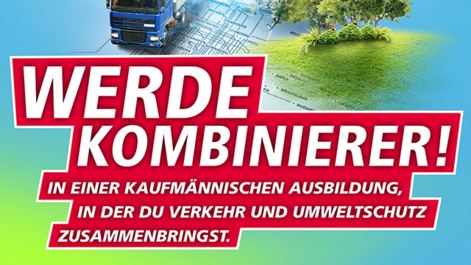
Start of training programme for new recruits in intermodal logistics
Since August 2017 Kombiverkehr has offered young people the opportunity to train for a career as a management assistant in forwarding and logistics. Kombiverkehr decided to offer a training programme in response to the current situation in the labour market, the shortage of skilled workers and the difficulty in recruiting staff who specialise in the business field of Combined Transport.
New apprentices are attracted through the attention-grabbing “Werde Kombinierer” advertising campaign. Interested parties can find useful information on training at Kombiverkehr on the web page “www.werde-kombinierer.de” and can apply for jobs directly online.
During the first few months of their training the new recruits visit and assist in numerous departments: from Sales and Transport Management to Billing and Invoice Verification or Corporate Communications. The apprentices learn how to prepare for exams and attend internal and external classes and advanced courses in order to gain their final qualifications. They also do a work placement with Spedition Bolloré, a partner company at Frankfurt Airport, in order to gain an understanding of other modes of transport.

Into the future together – Kombiverkehr is co-initiator of the KV 4.0 digitalisation project
In September 2017 the consortium partners Kombiverkehr, DB Cargo, Lokomotion, SBB Cargo Deutschland, KTL Kombi-Terminal Ludwigshafen, Hupac Transport, Hoyer, Paneuropa Transport, Hupac Intermodal, Bertschi and Hupac SpA begin work on a project entitled “Digitalisation of intermodal supply chains – KV 4.0”. Kombiverkehr is a co-initiator right from the beginning, taking a leading role in the project team. The company is thus playing an active part in this important scheme for the modernisation and future viability of the intermodal sector within the logistics industry.
As digitalisation gathers pace and customers call for more transparency in the supply chain, all the project partners are well aware that a standardised information network developed in close collaboration is the only way to improve the quality of the flow of information at a vertical level between forwarders, CT operators, rail freight companies and infrastructure providers. The core remit of the project is therefore the intelligent merging of these data fragments and the corresponding processing for different users. The overarching aim is to make the complex logistical process more transparent and manageable for users all the way along the intermodal transport chain and beyond national borders.
A newly developed shared data hub as well as standardised interfaces provides direct access to the relevant transport parameters (e.g. order and timetable information, estimated times of arrival and shipping information) that are developed and implemented specially for the requirements in Combined Transport. All project partners in the logistics industry are working collectively on the specification of the data hub, the definition of the interface and any necessary adjustments to business processes. One of the stated aims is the calculation in real time of virtually assured forecasts of pick-up times for transport units when trains run late. It is also intended that the findings of real-time data on the initial road leg will be used in order to optimise processes in the terminals and enable operators to make full use of train capacities.
The project is sponsored by the Federal Ministry of Transport and Digital Infrastructure (BMVI) within the framework of the Modernity Fund research initiative (mFUND).

In March 2023, we launched the new myKOMBIVERKEHR portal for greater data transparency and easy access to intermodal transport.
The portal offers our customers optimised information and data management, including tracking and information on suspensions and rebookings of loading units in real time, and boasts user-friendly user administration with immediate authorisation for all online services.
10 million transport orders were processed in our Capacity and Train Management system. CAT is the digital centrepiece of many applications connected via an interface and indirectly provides freight forwarding customers with all important data relating to transport orders.
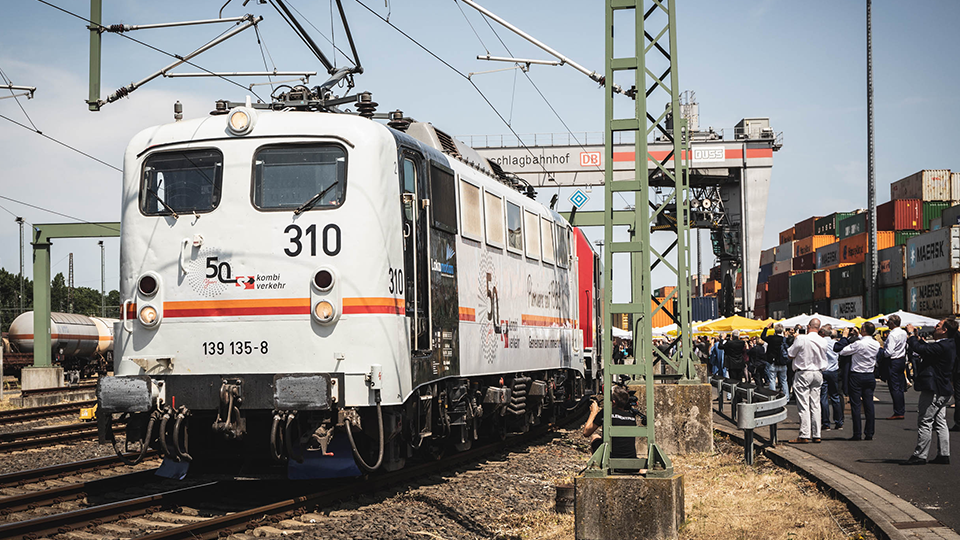
From interviews with contemporary witnesses to moving images from the 60s and 70s to the journey of our anniversary train. Experience an impression of 50 years of Kombiverkehr in sound and vision.
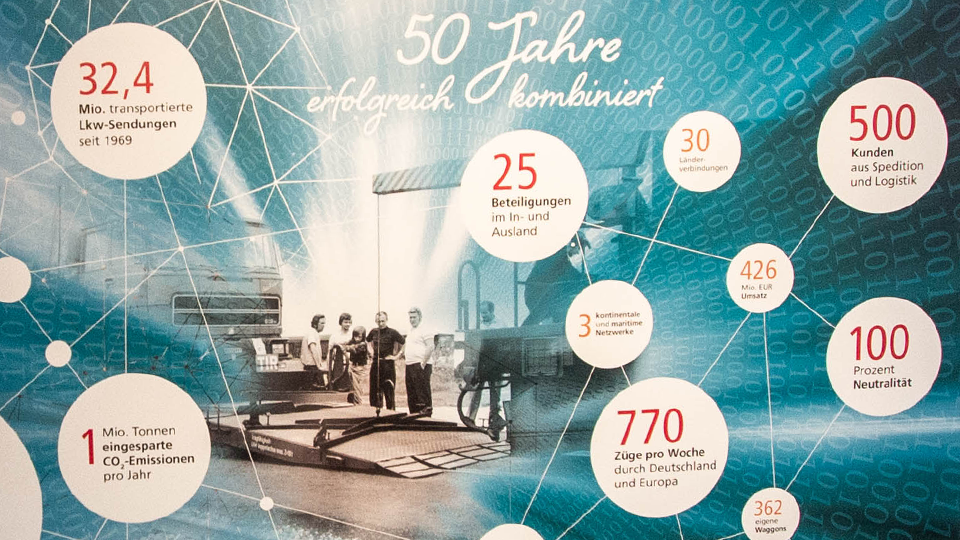
Find out all about the most exciting and special Kombiverkehr moments of the last five decades. Immerse yourself in fascinating stories and experience the milestones of our company in a very special way. We hope you enjoy our virtual journey through time "50 years of Kombiverkehr KG".
Notes on the application:
- Full screen view possible via right mouse button
- Zoom in via mouse function possible
- Various documents and photos can be enlarged with a mouse click
- Videos are played automatically from a certain viewing distance from the monitor or screen
